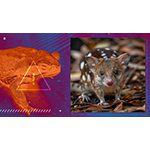Innovative technology mimics nature, providing the northern quoll a chance to avoid extinction in the fight against the invasive cane toad.
MELBOURNE, Australia & DALLAS–(BUSINESS WIRE)–Today scientists from Colossal Biosciences, the world’s first de-extinction company, and the University of Melbourne announce a major step forward in the effort to save Australia’s endangered northern quoll (Dasyurus hallucatus) from the invasive cane toad. The two organizations have performed genetic engineering with proprietary tools, to introduce genetic resistance in marsupial cells against the cane toad toxin. This is a crucial step towards a world-first application of gene-editing technologies for conserving a threatened species.
To achieve the world-first, the team will next derive induced pluripotent stem cells (iPSCs) from northern quolls, which can be CRISPR-edited to introduce the same genetic resistance, ultimately producing offspring who are cane toad toxin resistant. The offspring of these quolls will inherit this resistance and can then be released to rescue the threatened wild population. That heritable resistance will mean that no further intervention will be necessary to protect the species from the devastating impacts of the cane toad.
Quolls are carnivorous marsupials that play a crucial role in the Australian ecosystem as both a scavenger and a primary carnivore. They feed on invertebrates and vertebrates, while also consuming fruits (figs). Since the introduction of invasive cane toads (Rhinella marina) in Queensland in the 1930s, the northern quolls have seen their populations plummet by 75%. Cane toads have now become an attractive food source for the northern quoll, which is especially vulnerable to the toad’s neurotoxins. The toad is poisonous at all stages of its life cycle: eggs, tadpoles, toadlets and adult toads. As adults, the cane toad has venom-secreting poison glands (parotoid glands) on each shoulder that store and release poison. When ingested, victims experience rapid heartbeat, excessive salivation, convulsions and paralysis which results in death for the quoll and other native animals. Cane toads have spread well beyond Queensland into coastal New South Wales, the Northern Territory’s Top End and the Kimberley region of Western Australia and are rapidly moving westward. Their expansion threatens a complete extinction of the quoll species.
“We need northern quolls to have a balanced ecosystem in mainland Australia,” shared Professor Andrew Pask, who leads the Thylacine Integrated Genomic Restoration Research Laboratory at the School of BioSciences at the University of Melbourne. “By using Colossal’s technology we’re giving our conservation partners a fighting chance of succeeding in restoring that balance.”
“We discovered that select gene edits to the quoll could confer natural resistance,” said Dr. Stephen Frankenberg who heads up the quoll bufotoxin-resistance research team in Professor Pask’s lab, which includes PhD student Mr. Pierre Ibri. “That’s why we have dedicated our efforts to finding out how to save it.”
Dr. Stephen Frankenberg’s observations of other genetically resistant species led the team to hypothesize that the northern quolls could become genetically resistant with a very small genetic intervention. After several years of building resources from northern quoll tissue samples and introducing different genetic edits to the cells of a dunnart, which is closely related to the northern quoll (in the family Dasyuridae) and serves as a useful model species, the combined teams successfully engineered resistance in dunnart cells (which Colossal has used for its research in Thylacine de-extinction, and is closely related to the quoll) by introducing genetic features found in other natural predators of toads. The edited cells are 10-fold more toxin resistant in the context of cell culture. The team predicts this resistance will extend to the context of the whole animal. This is a substantial breakthrough in creating toxin resistance in all susceptible native animals, and proves that the vision set forth to create hereditary defense by Frankenberg, Pask and team is achievable.
“Colossal has been an invaluable partner in this project,” said Frankenberg. “With their expertise in the gene editing technologies that will ultimately lead to the de-extinction of entire species, we know we could be the first to use gene editing for the conservation of a threatened species.”
A preprint manuscript describing the initial CRISPR editing and demonstration of toxin resistance has been submitted to bioRxiv, prior to submission to a peer reviewed journal later this year. The team hopes that not only will the quolls become resistant but that they could become a primary predator of cane toads and help to slow and eventually reverse the cane toads growing population.
“This is cutting edge work in conservation, and an exciting idea. While there is still a way to go, this is an important development,” said Professor Ben Phillips, the Premier’s Science Fellow at Curtin University.
The team hopes to save other threatened species like goannas, freshwater crocodiles, tiger snakes, red-bellied black snakes, and death adders who also consume and can die from cane toads. Because cane toads are indiscriminate feeders, they out-compete native species, moving at an estimated 40-60 km per year. With the cane toad’s expansion into coastal New South Wales, the Northern Territory’s Top End and the Kimberley region of Western Australia, they put numerous predatory species at significant risk.
“One of the greatest threats that Australia’s wildlife faces is invasive species. Toxic prey, such as cane toads, have had devastating impacts on northern quolls, freshwater crocodiles, goannas, snakes, and many other native species. This advance, by Frankenberg and colleagues, is a crucial step towards a future that might give native wildlife a potential leg up over toads, and maybe even turn them from a deadly last meal to an abundant food supply,” said Euan G Ritchie, Professor of Wildlife Ecology and Conservation at Deakin University. “If northern quolls and other species could one day be resistant to toads, this could have a dramatic positive effect as it ripples through food webs and ecosystems. Innovation such as this is just what’s needed to help turn around Australia’s dire conservation record and better protect threatened species.”
As a next step in introducing toxin resistance to the northern quoll, the combined Colossal and University of Melbourne team has established eight northern quoll cell lines from pouch young. They are now working to reprogram those quoll fibroblasts into induced pluripotent stem cells (iPSCs). Once the iPSCs are generated, the scientists can correct the toxin susceptibility at the cellular level and thereby ensure hereditary resistance, which will give the northern quoll a fighting chance at survival. Colossal’s recent groundbreaking achievement with elephant iPSCs has shed additional light on the full potential of iPSC edits.
“Innovations like these are desperately needed for conservation today,” said the Chief Science Officer of Colossal, Beth Shapiro. “This is precisely why I joined Colossal – to leverage cutting-edge de-extinction and genetic rescue technologies to accelerate conservation efforts and restore and preserve at-risk ecosystems around the world. In this case, saving the northern quoll both sets a precedent for what is possible using these technologies and creates an opportunity for ecological feedbacks that will allow other Australian species to flourish.”
As this work expands, it will have a dramatic impact on conservation practices in Australia but could also be extended to other species affected by toads, such as some reptiles.
“It’s thrilling to see our de-extinction work for the Thylacine providing technology solutions for living endangered marsupials,” said Sara Ord, Director of Species Restoration at Colossal. “I expect we will be able to share many more of these breakthroughs as we continue our efforts.”
ABOUT COLOSSAL
Colossal was founded by emerging technology and software entrepreneur Ben Lamm and world-renowned geneticist and serial biotech entrepreneur George Church, Ph.D., and is the first to apply CRISPR technology for the purposes of species de-extinction. Colossal creates innovative technologies for species restoration, critically endangered species protection and the repopulation of critical ecosystems that support the continuation of life on Earth. Colossal is accepting humanity’s duty to restore Earth to a healthier state, while also solving for the future economies and biological necessities of the human condition through cutting-edge science and technologies. To follow along, please visit: www.colossal.com
Website: www.colossal.com
Twitter: https://twitter.com/itiscolossal
Instagram: https://www.instagram.com/itiscolossal/
LinkedIn: https://www.linkedin.com/company/itiscolossal/
Facebook: https://www.facebook.com/itiscolossal
Hashtag: #itiscolossal
ABOUT THE UNIVERSITY OF MELBOURNE
Established in 1853, the University of Melbourne is one of the oldest universities in Australia and the first in Victoria. The University’s purpose is to benefit society through the transformative impact of education and research. Nearly 10,000 academic and professional staff support a vibrant community of more than 52,000 students, including more than 20,000 international students from 150 countries. The University’s vision is to equip students with an outstanding education personalized around their interests and needs and embedded in a collaborative research culture. The University is embedded within world-class research and innovation precincts and engages with its communities and partners to address major social, economic, medical and environmental challenges. The University of Melbourne is ranked among the best universities in the world, delivering education and research that is global in reach, ambition and impact.
WEBSITE & SOCIALS
Website: www.unimelb.edu.au
Twitter: https://twitter.com/UniMelb
Instagram: https://www.instagram.com/unimelb
LinkedIn: https://www.linkedin.com/in/the-university-of-melbourne
Facebook: https://www.facebook.com/unimelb/
Contacts
COLOSSAL PRESS CONTACTS:
R&CPMK / [email protected]
Prosek / [email protected]






